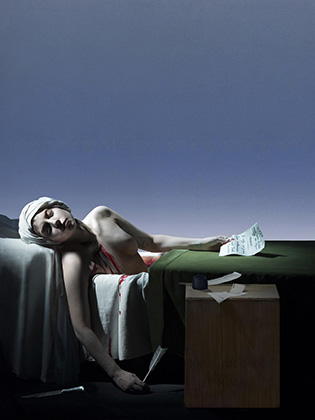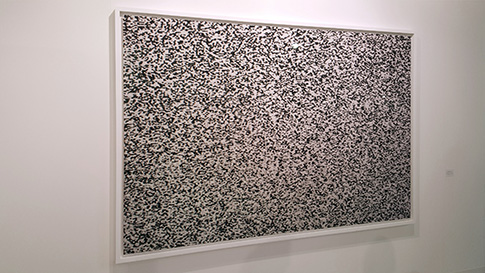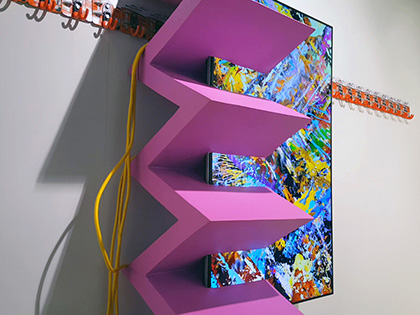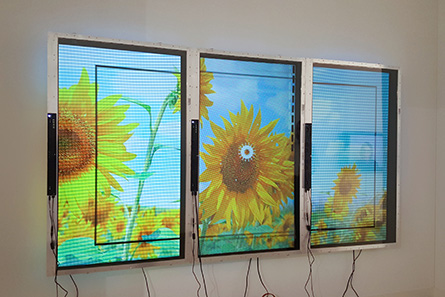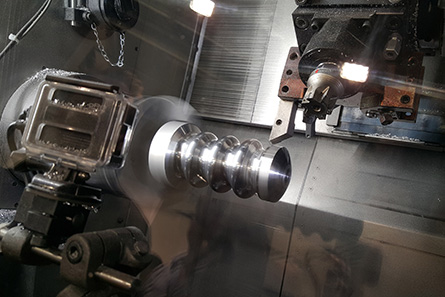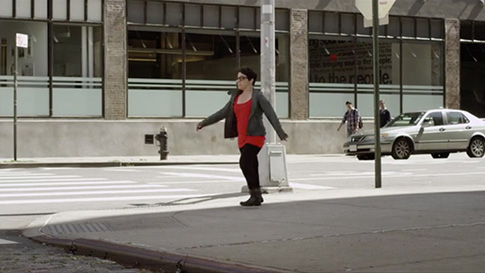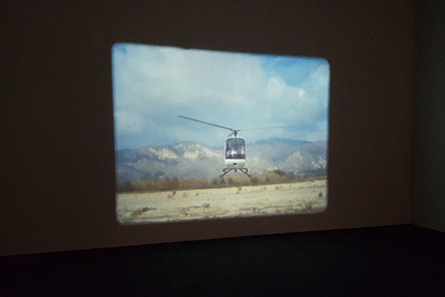ART BASEL 2015
by Dominique Moulon [ June 2015 ]
Returning from Art Basel, depending of one’s fortune, one comes back with works of art or figures, while others retain a reading of the trends in contemporary art. All practices, or almost all, are represented. So in order not to be too dispersed it is best to focus on a theme, support, or a medium, such as moving images for example.

Between painting, photography and cinema
Robert Wilson “Lady Gaga:
The Death of Marat”, 2013,
Courtesy RW Work Ltd,
Dissident Industries Inc
& Bernier/Eliades Gallery.
 Art Basel
Art Basel is nearly three hundred galleries that come together for a period of a week, so it is inevitable that one misses some works. Even if the presence of some, if only in video format, as is the case with Lady Gaga in the works of the multidisciplinary artist Robert Wilson, is noticed by all. With Flying, at the
Thomas Schulte gallery, she is suspended in a setting that evokes Shibari. On the stand of
Bernier/Eliades, she replays "The Death of Marat" that the painter Jacques Louis David immortalized in 1793.
Robert Wilson is well versed in video portraits of personalities. But with this reconstruction, initially exhibited at the Louvre where it barely drew any attention, it confronts a painting that has had such an impact on history it has spawned multiple replicas we all know. In this version by the director, the model is holding her breath such that time is suspended. Yet the "painting", which progressively lights up, induces a form of duration. This Death of Marat alone crystallizes the practices of painting, photography and film.

End of programmes
Wolfgang Tillmans
“ End of Broadcast VI”, 2014, Courtesy Chantal Crousel.
 A
Among the thirty countries represented, there are a few French galleries including that of
Chantal Crousel where in particular, one discovers the strange canvas framework of the artist
Wolfgang Tillmans. When looking very closely, one can see the interlacing threads of a black and white abstract embroidery. But it is the title of the print, "End of Broadcast," which gives us its ‘state’ and reality, for it is indeed the analogue noise that used to indicate the absence of a programme. "Snow", as that's what it is still called, which the most nostalgic of us may already regret, contained all the images of the world without broadcasting any. This was back when the programme was interrupted, when the tones of our fixed line telephones repeated incessantly. This snow, which we now call generative, as it never truly repeats in its infinite variations, expresses as much a lack as an excess along with its sonic equivalent, white noise. These are the visual and audio materials of absence that are also equivalent to all combined presence.

An aesthetic of excess
Borna Sammak, Art Basel,
2015, Courtesy JTT Gallery.
 I
In this fair of fairs, the works of four thousand artists interact with each other. Those of "historical" contemporary artists are mixed with those of emerging artists such as
Borna Sammak, from Brooklyn, at the New York
JTT Gallery. Four screens are presented, recessed or associated with objects of different natures and multiple materials or colours. But it is indeed images that captivate us to literally hypnotize us through an aesthetic of excess that is expressed in the depth of the image. Countless layers intermingle without anyone knowing where they come from, (perhaps from the Internet?). Extracted from the agglomeration of this saturated content, they illustrate a form of lyricism that painters know well, especially those whose practice consists of not stopping, of experimenting over time beyond a completion that would be of the order of the "reasonable". And we are told, in the corridors of the second floor of Hall 2, that the JTT gallery has sold everything.

Triptych
Tabor Robak
“Toys to life”, 2015,
Courtesy Team Gallery.
 S
Still on the second floor, where the emerging galleries are located, there is another Brooklyn artist on the stand of
Team Gallery:
Tabor Robak. The reference to painting is just as obvious, be it is only through the assembly of a triptych of flat screens whose contents are just as colourful. But here there is another form of depth that goes beyond the plane that we struggle to identify because translucent screens have been placed above the elements of the triptych. The graphics above increase the video or animated contents of what is below. And if there is a unity of style in the world of this American artist, it is still that of abundance over time. Nothing in what appears in the merging frames is truly predictable. There are as many surprises as there are images per second. This artistic proposal corresponds entirely to the generation of digital natives who appreciate the proliferation of content and media, provided however, you have seventy-five thousand dollars.

At the factory
Raphael Hefti, Art Basel, 2015,
Courtesy RaebervonStenglin.
 I
If there is a stand in Hall 2 of this forty-fifth edition of Art Basel that never empties, it is that of the
RaebervonStenglin Gallery. The public is gathered before a seven tonne CNC milling machine that the Swiss artist
Raphael Hefti has placed there. The machine mills with extreme precision while the show is broadcast live on two flat screens - In the sixties, artists invested the working world while in Basel, it is the factory that comes to the world of Art - and we must recognize that the accuracy of the machine fascinates as much as the turned volumes it executes, in every sense of the term. Because at the end of each performance there are only cylinders, similar in all respects to one another. Of this resolutely conceptual, ephemeral work, one can acquire only the instructions allowing one to reactivate the performance. Leaflets of the tool manufacturer are available to potential buyers, just like on the stands of an industrial show!

The singularity of gaits
Martin Creed,
“Work No. 1701”,
2013, Courtesy
Gavin Brown Gallery.
 I
It's time to go from Hall 2 to Hall 1, which houses an event entitled Unlimited, dedicated to personal exhibitions. The
Gavin Brown Gallery presents a sequence that resembles a music video. It was created by
Martin Creed who also composed the music and wrote the lyrics of the pop-rock song, You Return. It's one of those catchy songs which one can therefore listen to while it endlessly loops. But it also has the merit of playing down the situation of the image where ordinary people with strange mobility walk across the same crosswalk. Are they actors and / or disabled? The music punctuates their gestures, which dictates their movements to the camera. They all move with the same energy and everyone moves along with their own gait, right to the last guitar riff. But do we not all have bodily signatures of our own? The work of the English artist Martin Creed called "Work No. 1701" is simply a march dedicated to the peculiarities of these different styles we all have.

In suspension
Jacob Kassay,
“Untitled”, 2011,
Courtesy 303 Gallery.
 L
Lastly, it is a suspended helicopter that welcomes the public entering the black box of
Gallery 303. It was filmed by the artist Jacob Kassay and is broadcast via a sixteen-millimetre reel. The sound of the motorized flying machine mixes with that of the seductively obsolete projector. The helicopter seems to float above the floor of a desert as its blades are immobile, or almost. And if special effects are being used, they are resolutely analogue, operating when the blade rotation synchronizes with the aperture speed of the camera. The aligned time frames annihilate the movement of the propeller, but not that of the helicopter. This selective suppression is the result of an agreement, a symbiosis. During the first moments the spectators are dumbfounded by this artistic suspension, whose uncanny strangeness they continue to appreciate even after they’ve understood its origin. Is that not a possible definition of what art can be?

Written by Dominique Moulon for Art Press and translated by Geoffrey Finch, June 2015.
